Business Resources Report
VerifiedAdded on 2020/02/03
|13
|3406
|61
Report
AI Summary
This report provides a comprehensive analysis of various aspects of business resources, using Asda as a case study. It covers recruitment documentation (job descriptions, person specifications, application forms), employability, personal, and communication skills required for job roles. The report also details physical and technological resources used in Asda's operations. A significant portion is dedicated to exploring internal and external sources of finance, including retained earnings, current assets, personal savings, ordinary shares, preference shares, and term loans. The report interprets Asda's trading and profit & loss account and balance sheet, explaining key financial metrics like net sales revenue, gross profit, operating income, and net income. It illustrates the use of budgets for financial control, highlighting their role in limiting expenditures, creating financial roadmaps, and planning for future growth. Finally, the report presents a ratio analysis of Asda's financial state, examining liquidity ratios, profitability ratios, and leverage ratios to assess the company's financial health.
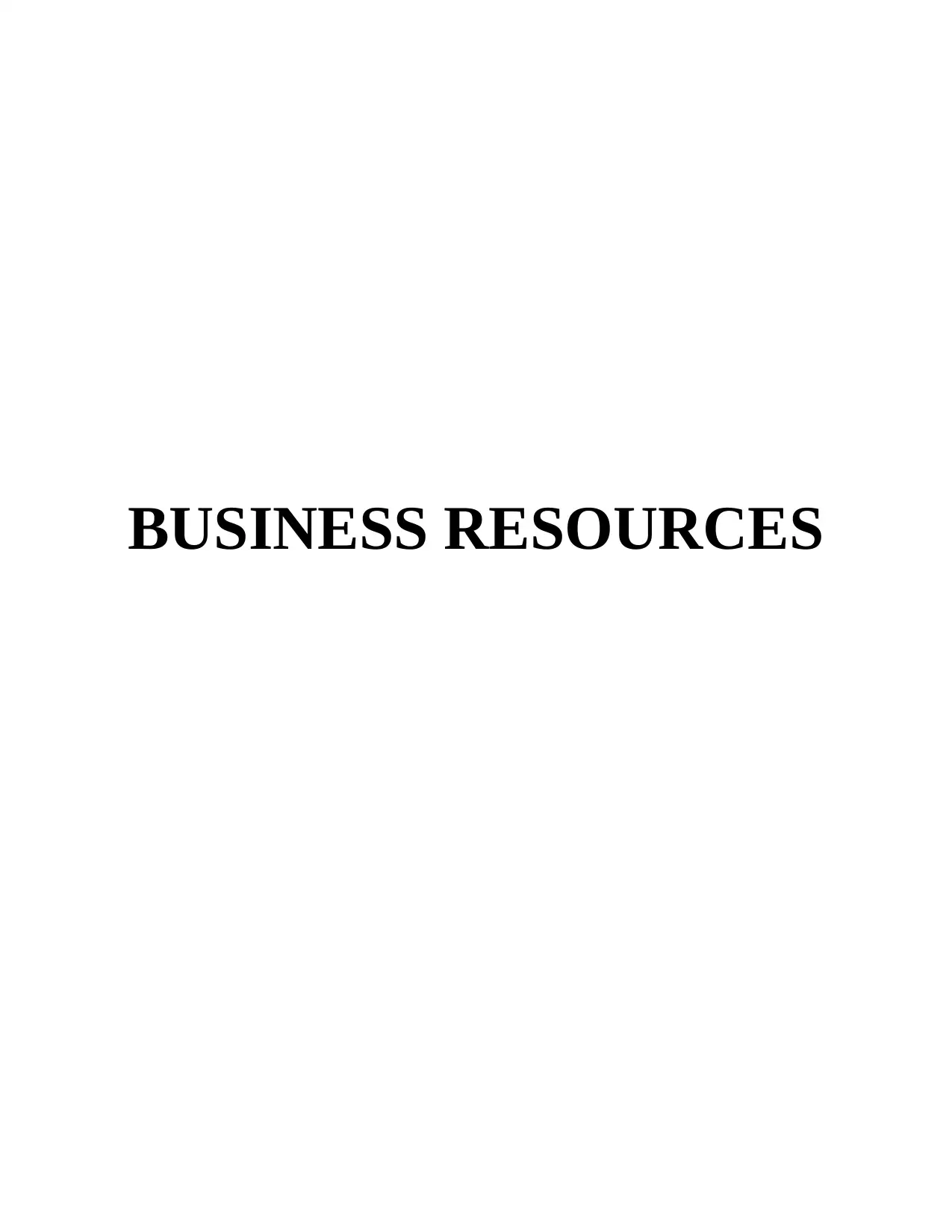
BUSINESS RESOURCES
Paraphrase This Document
Need a fresh take? Get an instant paraphrase of this document with our AI Paraphraser
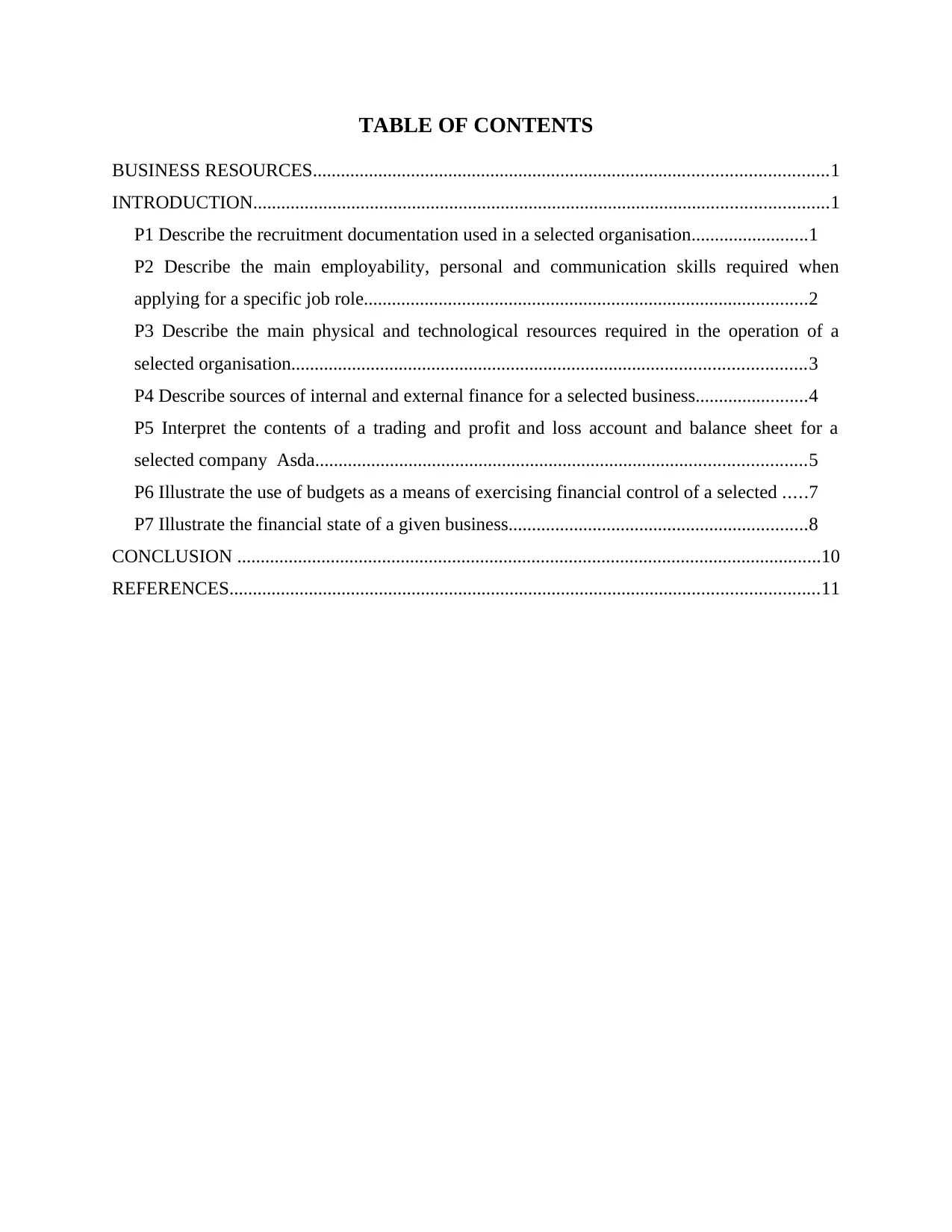
TABLE OF CONTENTS
BUSINESS RESOURCES..............................................................................................................1
INTRODUCTION...........................................................................................................................1
P1 Describe the recruitment documentation used in a selected organisation.........................1
P2 Describe the main employability, personal and communication skills required when
applying for a specific job role...............................................................................................2
P3 Describe the main physical and technological resources required in the operation of a
selected organisation..............................................................................................................3
P4 Describe sources of internal and external finance for a selected business........................4
P5 Interpret the contents of a trading and profit and loss account and balance sheet for a
selected company Asda.........................................................................................................5
P6 Illustrate the use of budgets as a means of exercising financial control of a selected .....7
P7 Illustrate the financial state of a given business................................................................8
CONCLUSION .............................................................................................................................10
REFERENCES..............................................................................................................................11
BUSINESS RESOURCES..............................................................................................................1
INTRODUCTION...........................................................................................................................1
P1 Describe the recruitment documentation used in a selected organisation.........................1
P2 Describe the main employability, personal and communication skills required when
applying for a specific job role...............................................................................................2
P3 Describe the main physical and technological resources required in the operation of a
selected organisation..............................................................................................................3
P4 Describe sources of internal and external finance for a selected business........................4
P5 Interpret the contents of a trading and profit and loss account and balance sheet for a
selected company Asda.........................................................................................................5
P6 Illustrate the use of budgets as a means of exercising financial control of a selected .....7
P7 Illustrate the financial state of a given business................................................................8
CONCLUSION .............................................................................................................................10
REFERENCES..............................................................................................................................11
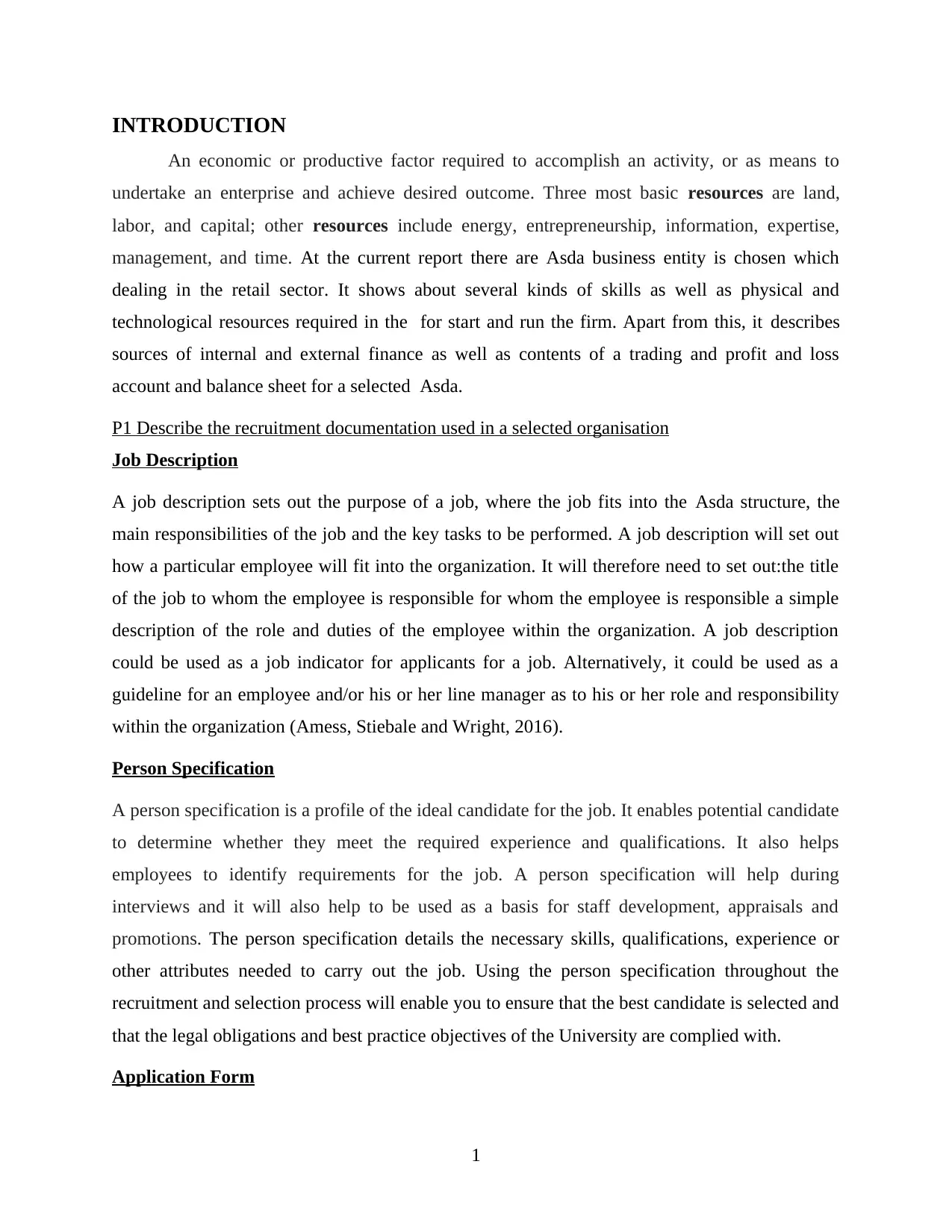
INTRODUCTION
An economic or productive factor required to accomplish an activity, or as means to
undertake an enterprise and achieve desired outcome. Three most basic resources are land,
labor, and capital; other resources include energy, entrepreneurship, information, expertise,
management, and time. At the current report there are Asda business entity is chosen which
dealing in the retail sector. It shows about several kinds of skills as well as physical and
technological resources required in the for start and run the firm. Apart from this, it describes
sources of internal and external finance as well as contents of a trading and profit and loss
account and balance sheet for a selected Asda.
P1 Describe the recruitment documentation used in a selected organisation
Job Description
A job description sets out the purpose of a job, where the job fits into the Asda structure, the
main responsibilities of the job and the key tasks to be performed. A job description will set out
how a particular employee will fit into the organization. It will therefore need to set out:the title
of the job to whom the employee is responsible for whom the employee is responsible a simple
description of the role and duties of the employee within the organization. A job description
could be used as a job indicator for applicants for a job. Alternatively, it could be used as a
guideline for an employee and/or his or her line manager as to his or her role and responsibility
within the organization (Amess, Stiebale and Wright, 2016).
Person Specification
A person specification is a profile of the ideal candidate for the job. It enables potential candidate
to determine whether they meet the required experience and qualifications. It also helps
employees to identify requirements for the job. A person specification will help during
interviews and it will also help to be used as a basis for staff development, appraisals and
promotions. The person specification details the necessary skills, qualifications, experience or
other attributes needed to carry out the job. Using the person specification throughout the
recruitment and selection process will enable you to ensure that the best candidate is selected and
that the legal obligations and best practice objectives of the University are complied with.
Application Form
1
An economic or productive factor required to accomplish an activity, or as means to
undertake an enterprise and achieve desired outcome. Three most basic resources are land,
labor, and capital; other resources include energy, entrepreneurship, information, expertise,
management, and time. At the current report there are Asda business entity is chosen which
dealing in the retail sector. It shows about several kinds of skills as well as physical and
technological resources required in the for start and run the firm. Apart from this, it describes
sources of internal and external finance as well as contents of a trading and profit and loss
account and balance sheet for a selected Asda.
P1 Describe the recruitment documentation used in a selected organisation
Job Description
A job description sets out the purpose of a job, where the job fits into the Asda structure, the
main responsibilities of the job and the key tasks to be performed. A job description will set out
how a particular employee will fit into the organization. It will therefore need to set out:the title
of the job to whom the employee is responsible for whom the employee is responsible a simple
description of the role and duties of the employee within the organization. A job description
could be used as a job indicator for applicants for a job. Alternatively, it could be used as a
guideline for an employee and/or his or her line manager as to his or her role and responsibility
within the organization (Amess, Stiebale and Wright, 2016).
Person Specification
A person specification is a profile of the ideal candidate for the job. It enables potential candidate
to determine whether they meet the required experience and qualifications. It also helps
employees to identify requirements for the job. A person specification will help during
interviews and it will also help to be used as a basis for staff development, appraisals and
promotions. The person specification details the necessary skills, qualifications, experience or
other attributes needed to carry out the job. Using the person specification throughout the
recruitment and selection process will enable you to ensure that the best candidate is selected and
that the legal obligations and best practice objectives of the University are complied with.
Application Form
1
⊘ This is a preview!⊘
Do you want full access?
Subscribe today to unlock all pages.

Trusted by 1+ million students worldwide
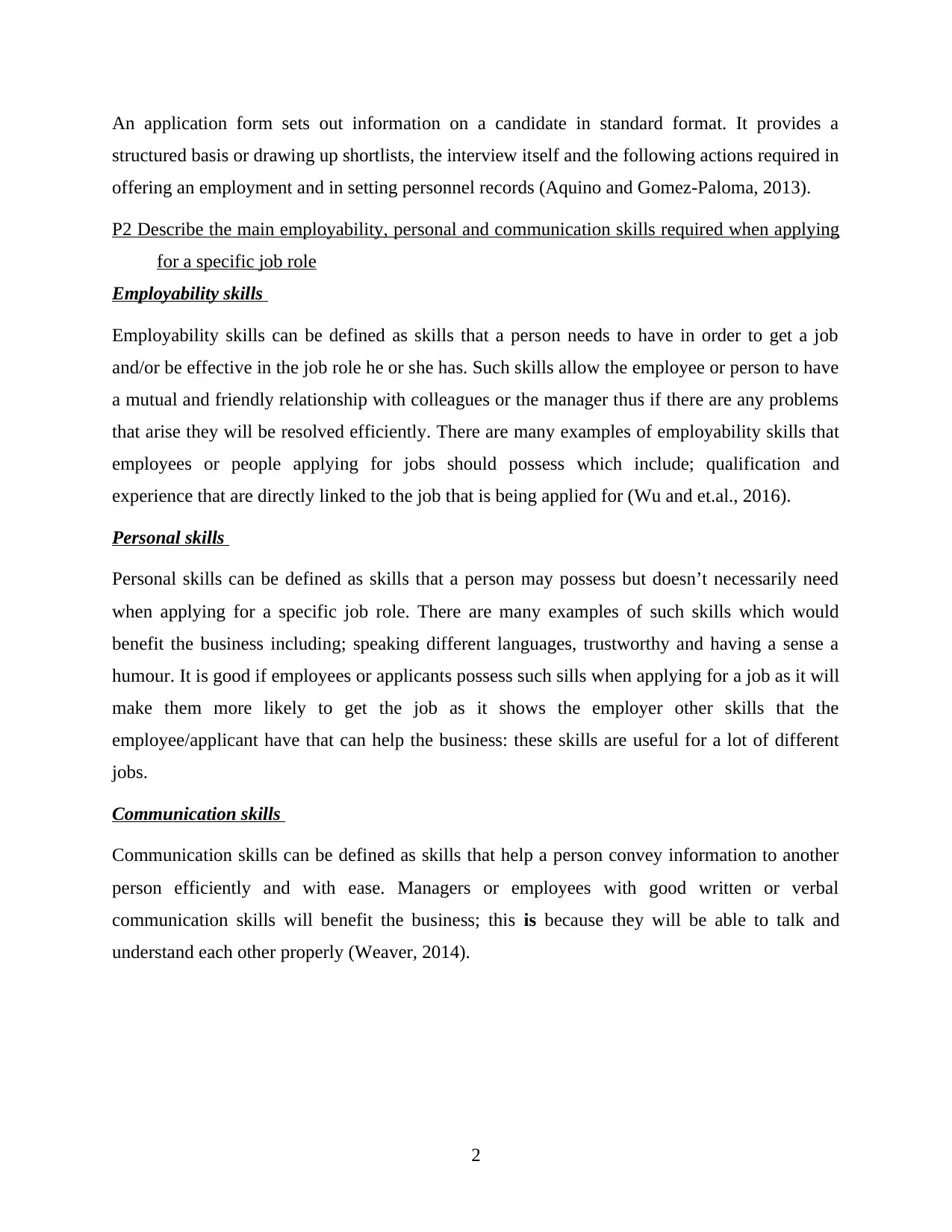
An application form sets out information on a candidate in standard format. It provides a
structured basis or drawing up shortlists, the interview itself and the following actions required in
offering an employment and in setting personnel records (Aquino and Gomez-Paloma, 2013).
P2 Describe the main employability, personal and communication skills required when applying
for a specific job role
Employability skills
Employability skills can be defined as skills that a person needs to have in order to get a job
and/or be effective in the job role he or she has. Such skills allow the employee or person to have
a mutual and friendly relationship with colleagues or the manager thus if there are any problems
that arise they will be resolved efficiently. There are many examples of employability skills that
employees or people applying for jobs should possess which include; qualification and
experience that are directly linked to the job that is being applied for (Wu and et.al., 2016).
Personal skills
Personal skills can be defined as skills that a person may possess but doesn’t necessarily need
when applying for a specific job role. There are many examples of such skills which would
benefit the business including; speaking different languages, trustworthy and having a sense a
humour. It is good if employees or applicants possess such sills when applying for a job as it will
make them more likely to get the job as it shows the employer other skills that the
employee/applicant have that can help the business: these skills are useful for a lot of different
jobs.
Communication skills
Communication skills can be defined as skills that help a person convey information to another
person efficiently and with ease. Managers or employees with good written or verbal
communication skills will benefit the business; this is because they will be able to talk and
understand each other properly (Weaver, 2014).
2
structured basis or drawing up shortlists, the interview itself and the following actions required in
offering an employment and in setting personnel records (Aquino and Gomez-Paloma, 2013).
P2 Describe the main employability, personal and communication skills required when applying
for a specific job role
Employability skills
Employability skills can be defined as skills that a person needs to have in order to get a job
and/or be effective in the job role he or she has. Such skills allow the employee or person to have
a mutual and friendly relationship with colleagues or the manager thus if there are any problems
that arise they will be resolved efficiently. There are many examples of employability skills that
employees or people applying for jobs should possess which include; qualification and
experience that are directly linked to the job that is being applied for (Wu and et.al., 2016).
Personal skills
Personal skills can be defined as skills that a person may possess but doesn’t necessarily need
when applying for a specific job role. There are many examples of such skills which would
benefit the business including; speaking different languages, trustworthy and having a sense a
humour. It is good if employees or applicants possess such sills when applying for a job as it will
make them more likely to get the job as it shows the employer other skills that the
employee/applicant have that can help the business: these skills are useful for a lot of different
jobs.
Communication skills
Communication skills can be defined as skills that help a person convey information to another
person efficiently and with ease. Managers or employees with good written or verbal
communication skills will benefit the business; this is because they will be able to talk and
understand each other properly (Weaver, 2014).
2
Paraphrase This Document
Need a fresh take? Get an instant paraphrase of this document with our AI Paraphraser
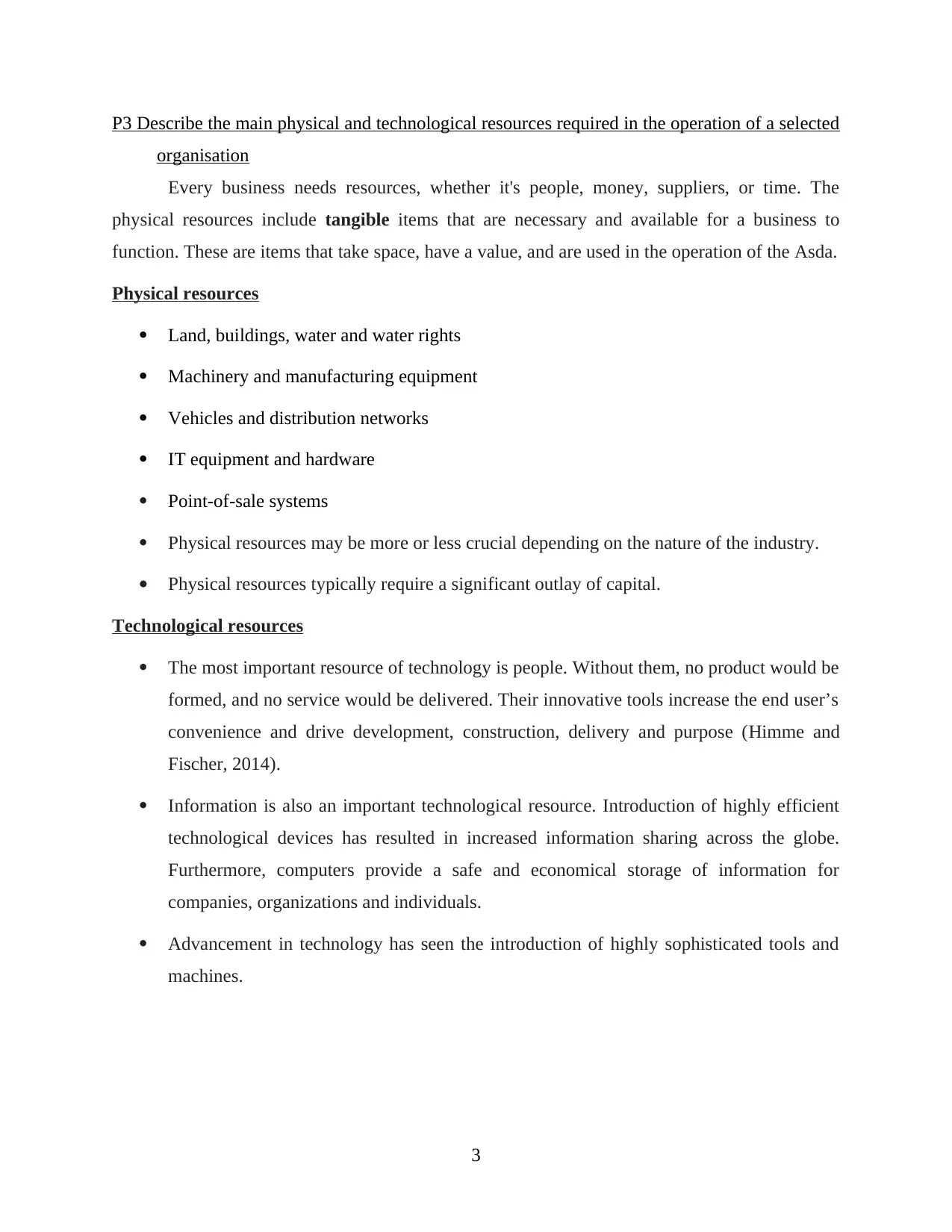
P3 Describe the main physical and technological resources required in the operation of a selected
organisation
Every business needs resources, whether it's people, money, suppliers, or time. The
physical resources include tangible items that are necessary and available for a business to
function. These are items that take space, have a value, and are used in the operation of the Asda.
Physical resources
Land, buildings, water and water rights
Machinery and manufacturing equipment
Vehicles and distribution networks
IT equipment and hardware
Point-of-sale systems
Physical resources may be more or less crucial depending on the nature of the industry.
Physical resources typically require a significant outlay of capital.
Technological resources
The most important resource of technology is people. Without them, no product would be
formed, and no service would be delivered. Their innovative tools increase the end user’s
convenience and drive development, construction, delivery and purpose (Himme and
Fischer, 2014).
Information is also an important technological resource. Introduction of highly efficient
technological devices has resulted in increased information sharing across the globe.
Furthermore, computers provide a safe and economical storage of information for
companies, organizations and individuals.
Advancement in technology has seen the introduction of highly sophisticated tools and
machines.
3
organisation
Every business needs resources, whether it's people, money, suppliers, or time. The
physical resources include tangible items that are necessary and available for a business to
function. These are items that take space, have a value, and are used in the operation of the Asda.
Physical resources
Land, buildings, water and water rights
Machinery and manufacturing equipment
Vehicles and distribution networks
IT equipment and hardware
Point-of-sale systems
Physical resources may be more or less crucial depending on the nature of the industry.
Physical resources typically require a significant outlay of capital.
Technological resources
The most important resource of technology is people. Without them, no product would be
formed, and no service would be delivered. Their innovative tools increase the end user’s
convenience and drive development, construction, delivery and purpose (Himme and
Fischer, 2014).
Information is also an important technological resource. Introduction of highly efficient
technological devices has resulted in increased information sharing across the globe.
Furthermore, computers provide a safe and economical storage of information for
companies, organizations and individuals.
Advancement in technology has seen the introduction of highly sophisticated tools and
machines.
3
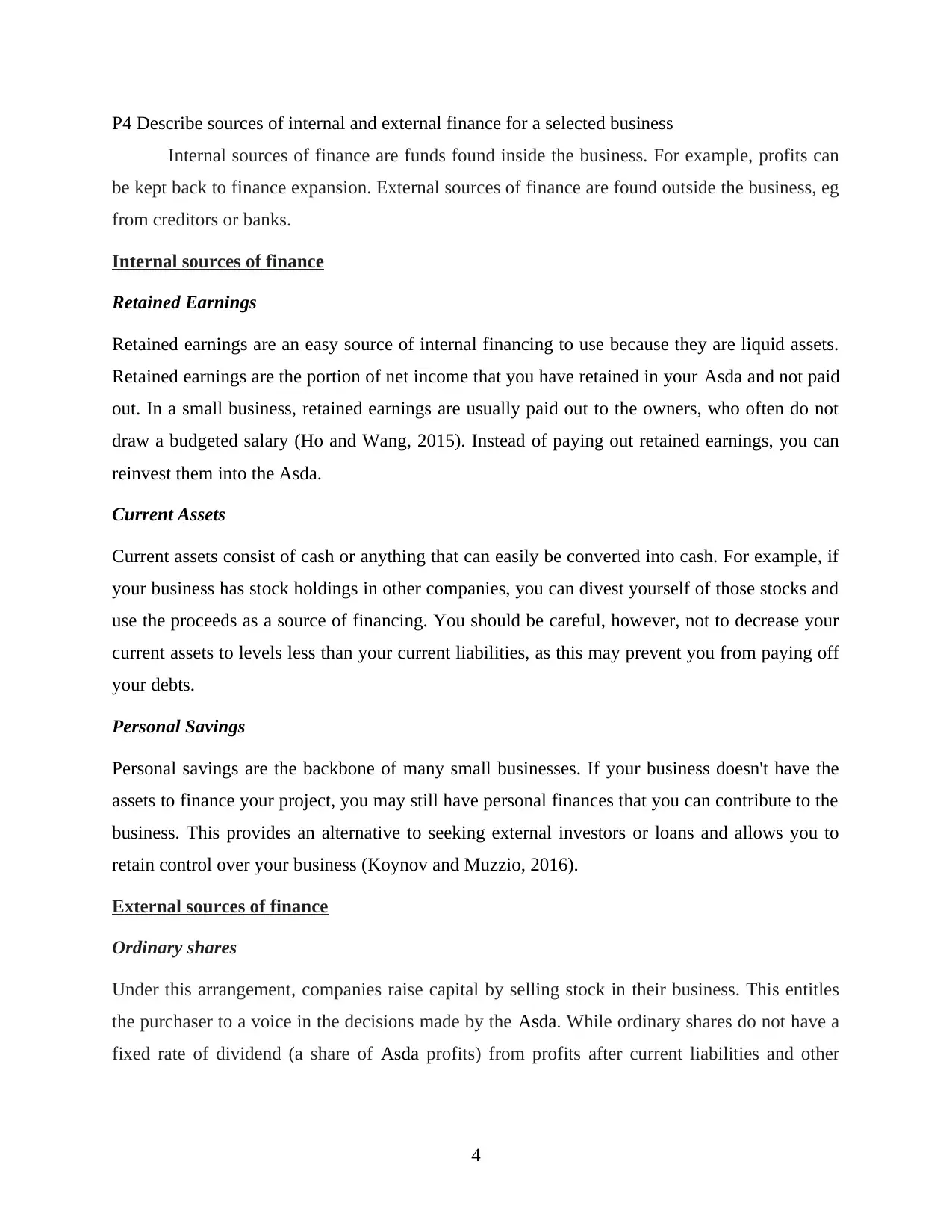
P4 Describe sources of internal and external finance for a selected business
Internal sources of finance are funds found inside the business. For example, profits can
be kept back to finance expansion. External sources of finance are found outside the business, eg
from creditors or banks.
Internal sources of finance
Retained Earnings
Retained earnings are an easy source of internal financing to use because they are liquid assets.
Retained earnings are the portion of net income that you have retained in your Asda and not paid
out. In a small business, retained earnings are usually paid out to the owners, who often do not
draw a budgeted salary (Ho and Wang, 2015). Instead of paying out retained earnings, you can
reinvest them into the Asda.
Current Assets
Current assets consist of cash or anything that can easily be converted into cash. For example, if
your business has stock holdings in other companies, you can divest yourself of those stocks and
use the proceeds as a source of financing. You should be careful, however, not to decrease your
current assets to levels less than your current liabilities, as this may prevent you from paying off
your debts.
Personal Savings
Personal savings are the backbone of many small businesses. If your business doesn't have the
assets to finance your project, you may still have personal finances that you can contribute to the
business. This provides an alternative to seeking external investors or loans and allows you to
retain control over your business (Koynov and Muzzio, 2016).
External sources of finance
Ordinary shares
Under this arrangement, companies raise capital by selling stock in their business. This entitles
the purchaser to a voice in the decisions made by the Asda. While ordinary shares do not have a
fixed rate of dividend (a share of Asda profits) from profits after current liabilities and other
4
Internal sources of finance are funds found inside the business. For example, profits can
be kept back to finance expansion. External sources of finance are found outside the business, eg
from creditors or banks.
Internal sources of finance
Retained Earnings
Retained earnings are an easy source of internal financing to use because they are liquid assets.
Retained earnings are the portion of net income that you have retained in your Asda and not paid
out. In a small business, retained earnings are usually paid out to the owners, who often do not
draw a budgeted salary (Ho and Wang, 2015). Instead of paying out retained earnings, you can
reinvest them into the Asda.
Current Assets
Current assets consist of cash or anything that can easily be converted into cash. For example, if
your business has stock holdings in other companies, you can divest yourself of those stocks and
use the proceeds as a source of financing. You should be careful, however, not to decrease your
current assets to levels less than your current liabilities, as this may prevent you from paying off
your debts.
Personal Savings
Personal savings are the backbone of many small businesses. If your business doesn't have the
assets to finance your project, you may still have personal finances that you can contribute to the
business. This provides an alternative to seeking external investors or loans and allows you to
retain control over your business (Koynov and Muzzio, 2016).
External sources of finance
Ordinary shares
Under this arrangement, companies raise capital by selling stock in their business. This entitles
the purchaser to a voice in the decisions made by the Asda. While ordinary shares do not have a
fixed rate of dividend (a share of Asda profits) from profits after current liabilities and other
4
⊘ This is a preview!⊘
Do you want full access?
Subscribe today to unlock all pages.

Trusted by 1+ million students worldwide
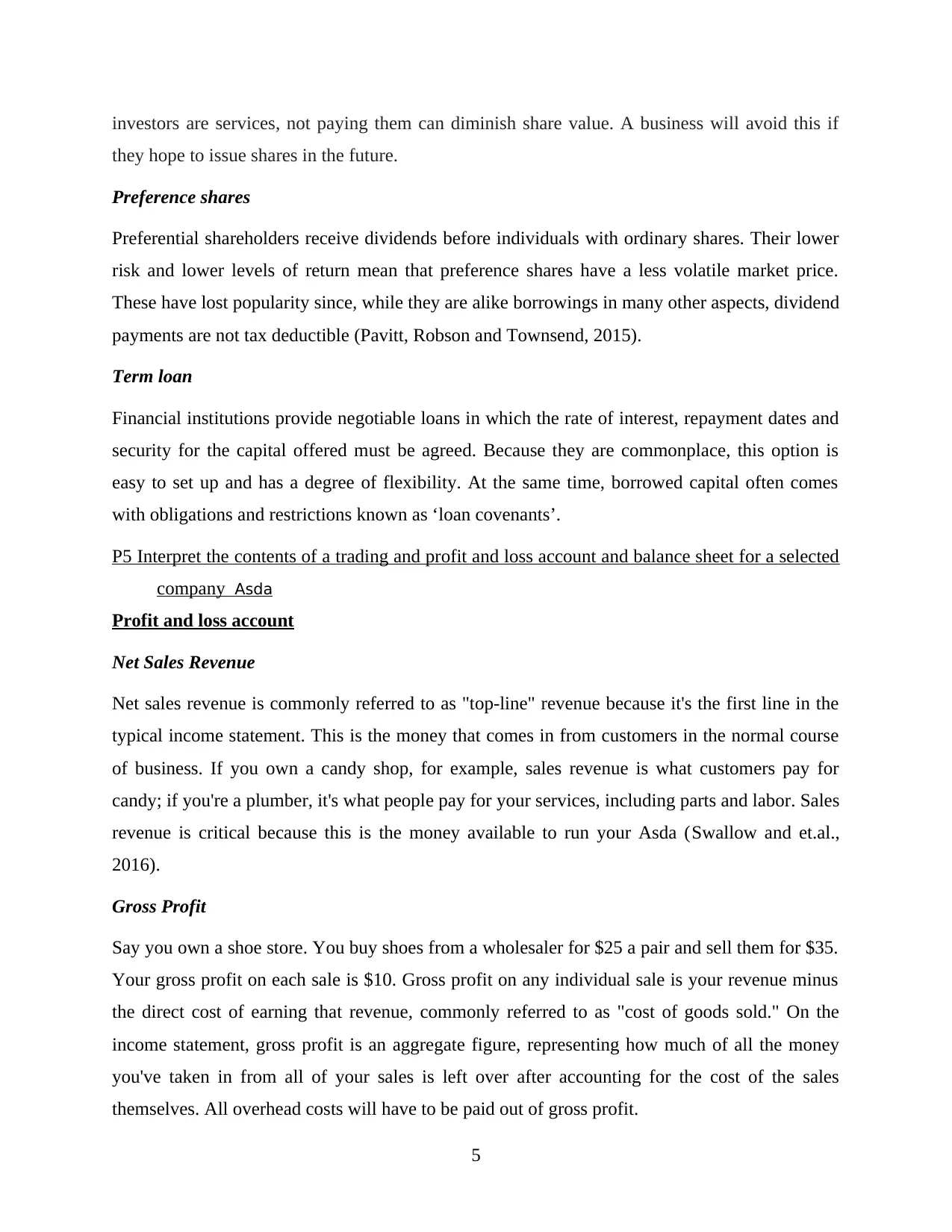
investors are services, not paying them can diminish share value. A business will avoid this if
they hope to issue shares in the future.
Preference shares
Preferential shareholders receive dividends before individuals with ordinary shares. Their lower
risk and lower levels of return mean that preference shares have a less volatile market price.
These have lost popularity since, while they are alike borrowings in many other aspects, dividend
payments are not tax deductible (Pavitt, Robson and Townsend, 2015).
Term loan
Financial institutions provide negotiable loans in which the rate of interest, repayment dates and
security for the capital offered must be agreed. Because they are commonplace, this option is
easy to set up and has a degree of flexibility. At the same time, borrowed capital often comes
with obligations and restrictions known as ‘loan covenants’.
P5 Interpret the contents of a trading and profit and loss account and balance sheet for a selected
company Asda
Profit and loss account
Net Sales Revenue
Net sales revenue is commonly referred to as "top-line" revenue because it's the first line in the
typical income statement. This is the money that comes in from customers in the normal course
of business. If you own a candy shop, for example, sales revenue is what customers pay for
candy; if you're a plumber, it's what people pay for your services, including parts and labor. Sales
revenue is critical because this is the money available to run your Asda (Swallow and et.al.,
2016).
Gross Profit
Say you own a shoe store. You buy shoes from a wholesaler for $25 a pair and sell them for $35.
Your gross profit on each sale is $10. Gross profit on any individual sale is your revenue minus
the direct cost of earning that revenue, commonly referred to as "cost of goods sold." On the
income statement, gross profit is an aggregate figure, representing how much of all the money
you've taken in from all of your sales is left over after accounting for the cost of the sales
themselves. All overhead costs will have to be paid out of gross profit.
5
they hope to issue shares in the future.
Preference shares
Preferential shareholders receive dividends before individuals with ordinary shares. Their lower
risk and lower levels of return mean that preference shares have a less volatile market price.
These have lost popularity since, while they are alike borrowings in many other aspects, dividend
payments are not tax deductible (Pavitt, Robson and Townsend, 2015).
Term loan
Financial institutions provide negotiable loans in which the rate of interest, repayment dates and
security for the capital offered must be agreed. Because they are commonplace, this option is
easy to set up and has a degree of flexibility. At the same time, borrowed capital often comes
with obligations and restrictions known as ‘loan covenants’.
P5 Interpret the contents of a trading and profit and loss account and balance sheet for a selected
company Asda
Profit and loss account
Net Sales Revenue
Net sales revenue is commonly referred to as "top-line" revenue because it's the first line in the
typical income statement. This is the money that comes in from customers in the normal course
of business. If you own a candy shop, for example, sales revenue is what customers pay for
candy; if you're a plumber, it's what people pay for your services, including parts and labor. Sales
revenue is critical because this is the money available to run your Asda (Swallow and et.al.,
2016).
Gross Profit
Say you own a shoe store. You buy shoes from a wholesaler for $25 a pair and sell them for $35.
Your gross profit on each sale is $10. Gross profit on any individual sale is your revenue minus
the direct cost of earning that revenue, commonly referred to as "cost of goods sold." On the
income statement, gross profit is an aggregate figure, representing how much of all the money
you've taken in from all of your sales is left over after accounting for the cost of the sales
themselves. All overhead costs will have to be paid out of gross profit.
5
Paraphrase This Document
Need a fresh take? Get an instant paraphrase of this document with our AI Paraphraser
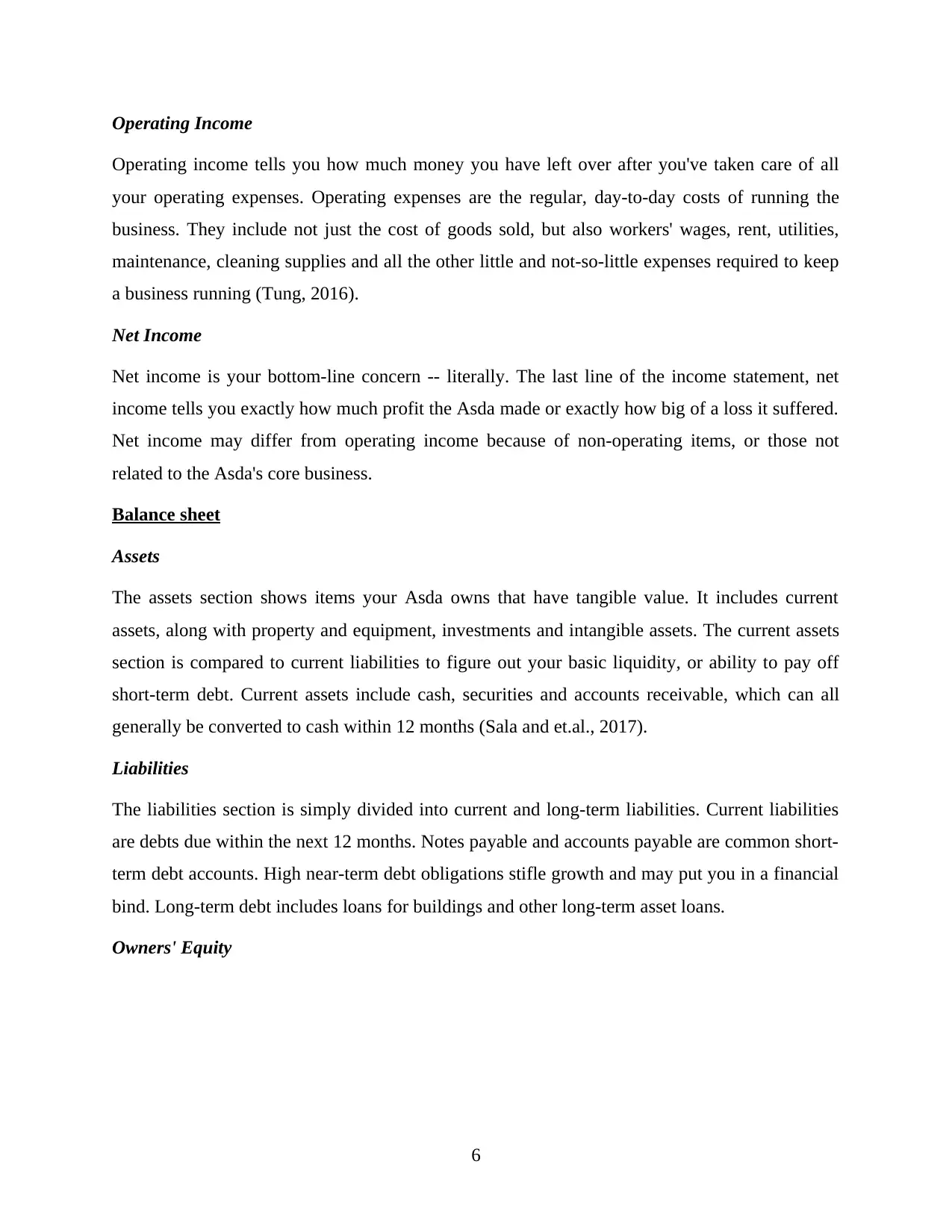
Operating Income
Operating income tells you how much money you have left over after you've taken care of all
your operating expenses. Operating expenses are the regular, day-to-day costs of running the
business. They include not just the cost of goods sold, but also workers' wages, rent, utilities,
maintenance, cleaning supplies and all the other little and not-so-little expenses required to keep
a business running (Tung, 2016).
Net Income
Net income is your bottom-line concern -- literally. The last line of the income statement, net
income tells you exactly how much profit the Asda made or exactly how big of a loss it suffered.
Net income may differ from operating income because of non-operating items, or those not
related to the Asda's core business.
Balance sheet
Assets
The assets section shows items your Asda owns that have tangible value. It includes current
assets, along with property and equipment, investments and intangible assets. The current assets
section is compared to current liabilities to figure out your basic liquidity, or ability to pay off
short-term debt. Current assets include cash, securities and accounts receivable, which can all
generally be converted to cash within 12 months (Sala and et.al., 2017).
Liabilities
The liabilities section is simply divided into current and long-term liabilities. Current liabilities
are debts due within the next 12 months. Notes payable and accounts payable are common short-
term debt accounts. High near-term debt obligations stifle growth and may put you in a financial
bind. Long-term debt includes loans for buildings and other long-term asset loans.
Owners' Equity
6
Operating income tells you how much money you have left over after you've taken care of all
your operating expenses. Operating expenses are the regular, day-to-day costs of running the
business. They include not just the cost of goods sold, but also workers' wages, rent, utilities,
maintenance, cleaning supplies and all the other little and not-so-little expenses required to keep
a business running (Tung, 2016).
Net Income
Net income is your bottom-line concern -- literally. The last line of the income statement, net
income tells you exactly how much profit the Asda made or exactly how big of a loss it suffered.
Net income may differ from operating income because of non-operating items, or those not
related to the Asda's core business.
Balance sheet
Assets
The assets section shows items your Asda owns that have tangible value. It includes current
assets, along with property and equipment, investments and intangible assets. The current assets
section is compared to current liabilities to figure out your basic liquidity, or ability to pay off
short-term debt. Current assets include cash, securities and accounts receivable, which can all
generally be converted to cash within 12 months (Sala and et.al., 2017).
Liabilities
The liabilities section is simply divided into current and long-term liabilities. Current liabilities
are debts due within the next 12 months. Notes payable and accounts payable are common short-
term debt accounts. High near-term debt obligations stifle growth and may put you in a financial
bind. Long-term debt includes loans for buildings and other long-term asset loans.
Owners' Equity
6
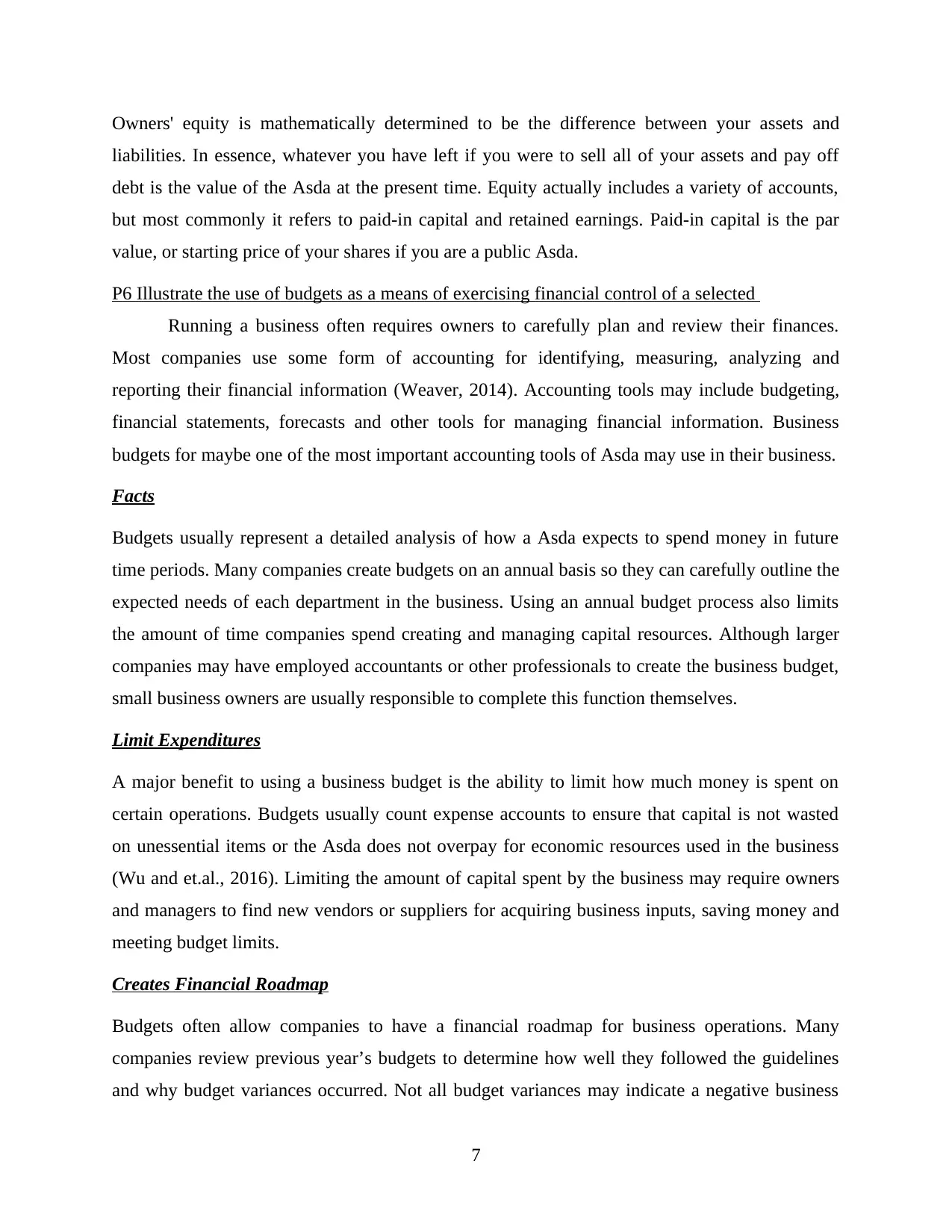
Owners' equity is mathematically determined to be the difference between your assets and
liabilities. In essence, whatever you have left if you were to sell all of your assets and pay off
debt is the value of the Asda at the present time. Equity actually includes a variety of accounts,
but most commonly it refers to paid-in capital and retained earnings. Paid-in capital is the par
value, or starting price of your shares if you are a public Asda.
P6 Illustrate the use of budgets as a means of exercising financial control of a selected
Running a business often requires owners to carefully plan and review their finances.
Most companies use some form of accounting for identifying, measuring, analyzing and
reporting their financial information (Weaver, 2014). Accounting tools may include budgeting,
financial statements, forecasts and other tools for managing financial information. Business
budgets for maybe one of the most important accounting tools of Asda may use in their business.
Facts
Budgets usually represent a detailed analysis of how a Asda expects to spend money in future
time periods. Many companies create budgets on an annual basis so they can carefully outline the
expected needs of each department in the business. Using an annual budget process also limits
the amount of time companies spend creating and managing capital resources. Although larger
companies may have employed accountants or other professionals to create the business budget,
small business owners are usually responsible to complete this function themselves.
Limit Expenditures
A major benefit to using a business budget is the ability to limit how much money is spent on
certain operations. Budgets usually count expense accounts to ensure that capital is not wasted
on unessential items or the Asda does not overpay for economic resources used in the business
(Wu and et.al., 2016). Limiting the amount of capital spent by the business may require owners
and managers to find new vendors or suppliers for acquiring business inputs, saving money and
meeting budget limits.
Creates Financial Roadmap
Budgets often allow companies to have a financial roadmap for business operations. Many
companies review previous year’s budgets to determine how well they followed the guidelines
and why budget variances occurred. Not all budget variances may indicate a negative business
7
liabilities. In essence, whatever you have left if you were to sell all of your assets and pay off
debt is the value of the Asda at the present time. Equity actually includes a variety of accounts,
but most commonly it refers to paid-in capital and retained earnings. Paid-in capital is the par
value, or starting price of your shares if you are a public Asda.
P6 Illustrate the use of budgets as a means of exercising financial control of a selected
Running a business often requires owners to carefully plan and review their finances.
Most companies use some form of accounting for identifying, measuring, analyzing and
reporting their financial information (Weaver, 2014). Accounting tools may include budgeting,
financial statements, forecasts and other tools for managing financial information. Business
budgets for maybe one of the most important accounting tools of Asda may use in their business.
Facts
Budgets usually represent a detailed analysis of how a Asda expects to spend money in future
time periods. Many companies create budgets on an annual basis so they can carefully outline the
expected needs of each department in the business. Using an annual budget process also limits
the amount of time companies spend creating and managing capital resources. Although larger
companies may have employed accountants or other professionals to create the business budget,
small business owners are usually responsible to complete this function themselves.
Limit Expenditures
A major benefit to using a business budget is the ability to limit how much money is spent on
certain operations. Budgets usually count expense accounts to ensure that capital is not wasted
on unessential items or the Asda does not overpay for economic resources used in the business
(Wu and et.al., 2016). Limiting the amount of capital spent by the business may require owners
and managers to find new vendors or suppliers for acquiring business inputs, saving money and
meeting budget limits.
Creates Financial Roadmap
Budgets often allow companies to have a financial roadmap for business operations. Many
companies review previous year’s budgets to determine how well they followed the guidelines
and why budget variances occurred. Not all budget variances may indicate a negative business
7
⊘ This is a preview!⊘
Do you want full access?
Subscribe today to unlock all pages.

Trusted by 1+ million students worldwide
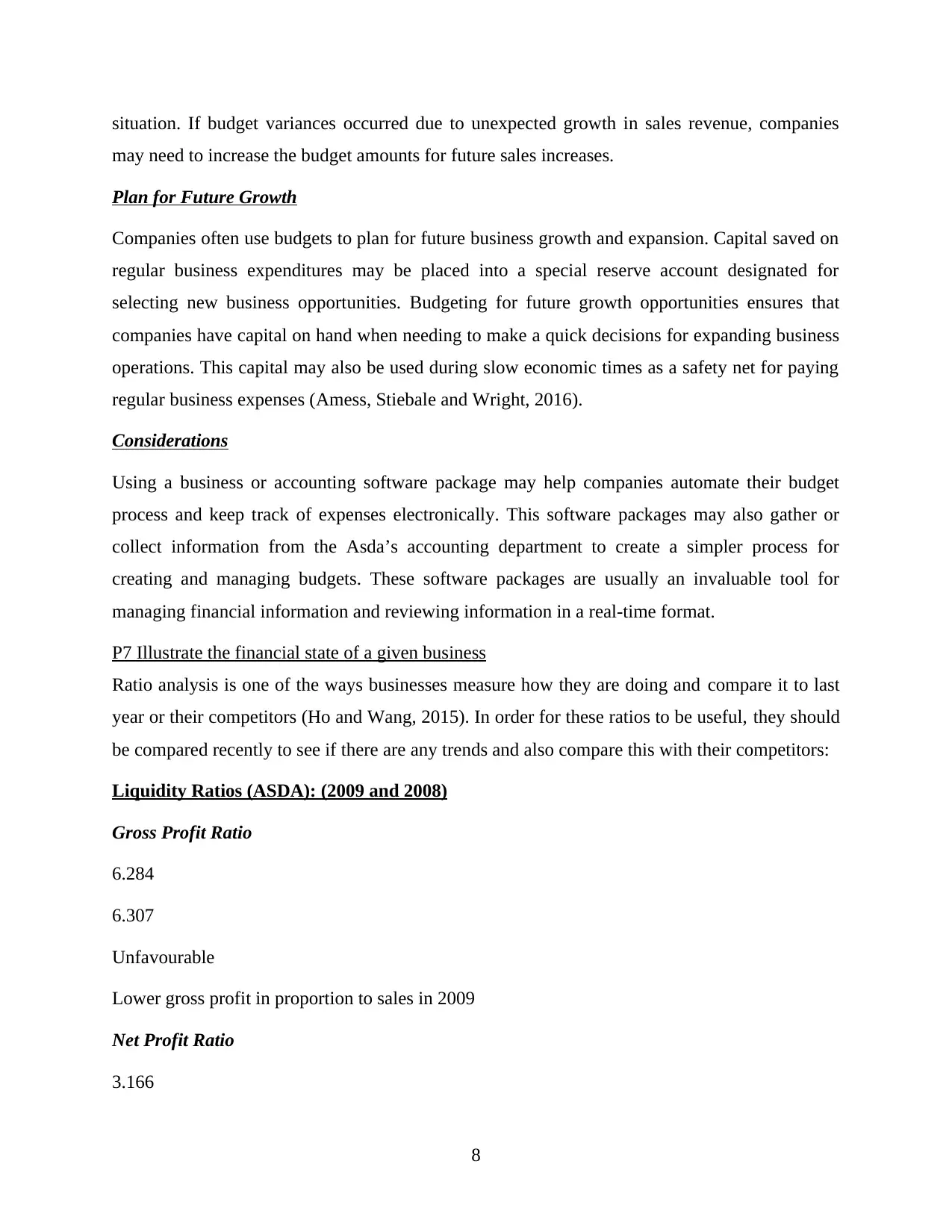
situation. If budget variances occurred due to unexpected growth in sales revenue, companies
may need to increase the budget amounts for future sales increases.
Plan for Future Growth
Companies often use budgets to plan for future business growth and expansion. Capital saved on
regular business expenditures may be placed into a special reserve account designated for
selecting new business opportunities. Budgeting for future growth opportunities ensures that
companies have capital on hand when needing to make a quick decisions for expanding business
operations. This capital may also be used during slow economic times as a safety net for paying
regular business expenses (Amess, Stiebale and Wright, 2016).
Considerations
Using a business or accounting software package may help companies automate their budget
process and keep track of expenses electronically. This software packages may also gather or
collect information from the Asda’s accounting department to create a simpler process for
creating and managing budgets. These software packages are usually an invaluable tool for
managing financial information and reviewing information in a real-time format.
P7 Illustrate the financial state of a given business
Ratio analysis is one of the ways businesses measure how they are doing and compare it to last
year or their competitors (Ho and Wang, 2015). In order for these ratios to be useful, they should
be compared recently to see if there are any trends and also compare this with their competitors:
Liquidity Ratios (ASDA): (2009 and 2008)
Gross Profit Ratio
6.284
6.307
Unfavourable
Lower gross profit in proportion to sales in 2009
Net Profit Ratio
3.166
8
may need to increase the budget amounts for future sales increases.
Plan for Future Growth
Companies often use budgets to plan for future business growth and expansion. Capital saved on
regular business expenditures may be placed into a special reserve account designated for
selecting new business opportunities. Budgeting for future growth opportunities ensures that
companies have capital on hand when needing to make a quick decisions for expanding business
operations. This capital may also be used during slow economic times as a safety net for paying
regular business expenses (Amess, Stiebale and Wright, 2016).
Considerations
Using a business or accounting software package may help companies automate their budget
process and keep track of expenses electronically. This software packages may also gather or
collect information from the Asda’s accounting department to create a simpler process for
creating and managing budgets. These software packages are usually an invaluable tool for
managing financial information and reviewing information in a real-time format.
P7 Illustrate the financial state of a given business
Ratio analysis is one of the ways businesses measure how they are doing and compare it to last
year or their competitors (Ho and Wang, 2015). In order for these ratios to be useful, they should
be compared recently to see if there are any trends and also compare this with their competitors:
Liquidity Ratios (ASDA): (2009 and 2008)
Gross Profit Ratio
6.284
6.307
Unfavourable
Lower gross profit in proportion to sales in 2009
Net Profit Ratio
3.166
8
Paraphrase This Document
Need a fresh take? Get an instant paraphrase of this document with our AI Paraphraser
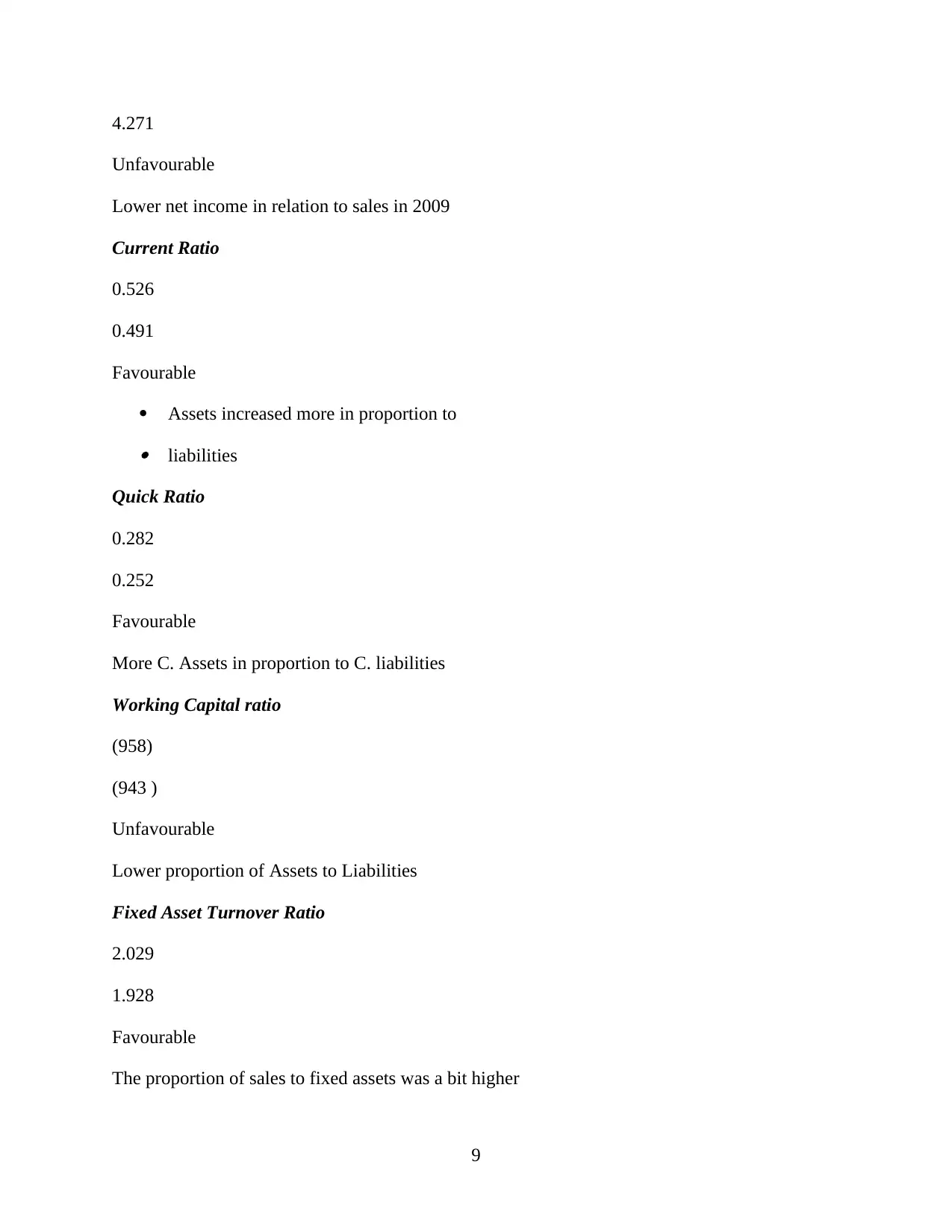
4.271
Unfavourable
Lower net income in relation to sales in 2009
Current Ratio
0.526
0.491
Favourable
Assets increased more in proportion to liabilities
Quick Ratio
0.282
0.252
Favourable
More C. Assets in proportion to C. liabilities
Working Capital ratio
(958)
(943 )
Unfavourable
Lower proportion of Assets to Liabilities
Fixed Asset Turnover Ratio
2.029
1.928
Favourable
The proportion of sales to fixed assets was a bit higher
9
Unfavourable
Lower net income in relation to sales in 2009
Current Ratio
0.526
0.491
Favourable
Assets increased more in proportion to liabilities
Quick Ratio
0.282
0.252
Favourable
More C. Assets in proportion to C. liabilities
Working Capital ratio
(958)
(943 )
Unfavourable
Lower proportion of Assets to Liabilities
Fixed Asset Turnover Ratio
2.029
1.928
Favourable
The proportion of sales to fixed assets was a bit higher
9
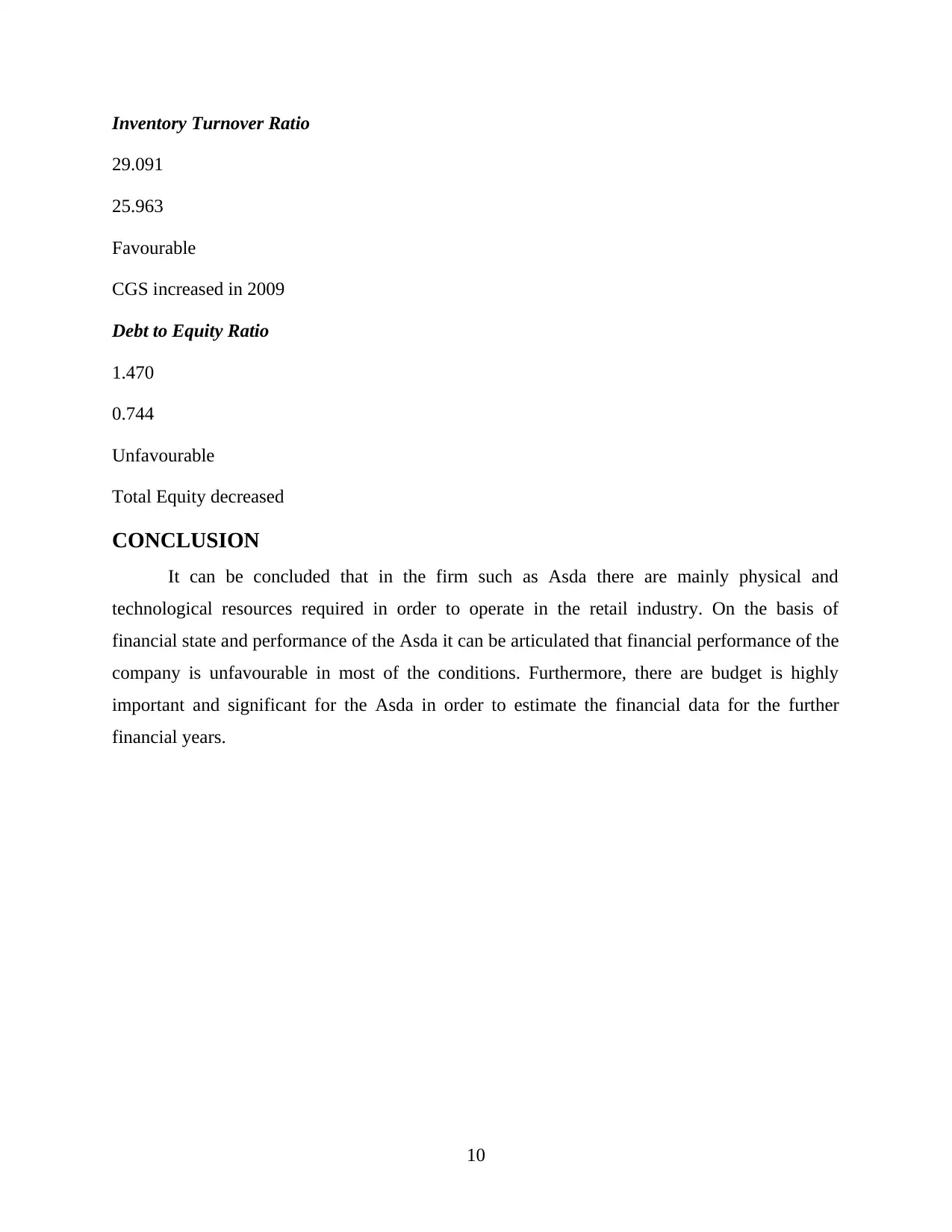
Inventory Turnover Ratio
29.091
25.963
Favourable
CGS increased in 2009
Debt to Equity Ratio
1.470
0.744
Unfavourable
Total Equity decreased
CONCLUSION
It can be concluded that in the firm such as Asda there are mainly physical and
technological resources required in order to operate in the retail industry. On the basis of
financial state and performance of the Asda it can be articulated that financial performance of the
company is unfavourable in most of the conditions. Furthermore, there are budget is highly
important and significant for the Asda in order to estimate the financial data for the further
financial years.
10
29.091
25.963
Favourable
CGS increased in 2009
Debt to Equity Ratio
1.470
0.744
Unfavourable
Total Equity decreased
CONCLUSION
It can be concluded that in the firm such as Asda there are mainly physical and
technological resources required in order to operate in the retail industry. On the basis of
financial state and performance of the Asda it can be articulated that financial performance of the
company is unfavourable in most of the conditions. Furthermore, there are budget is highly
important and significant for the Asda in order to estimate the financial data for the further
financial years.
10
⊘ This is a preview!⊘
Do you want full access?
Subscribe today to unlock all pages.

Trusted by 1+ million students worldwide
1 out of 13
Related Documents
Your All-in-One AI-Powered Toolkit for Academic Success.
+13062052269
info@desklib.com
Available 24*7 on WhatsApp / Email
![[object Object]](/_next/static/media/star-bottom.7253800d.svg)
Unlock your academic potential
Copyright © 2020–2025 A2Z Services. All Rights Reserved. Developed and managed by ZUCOL.





